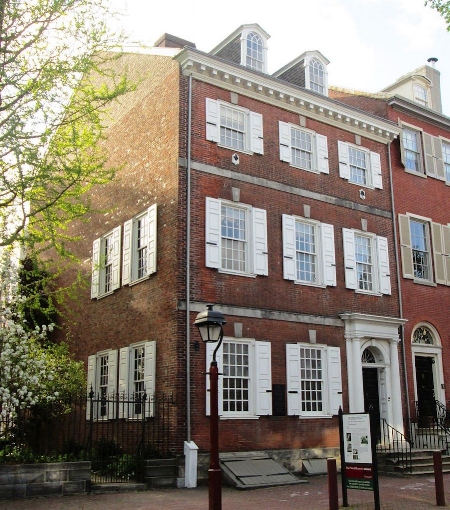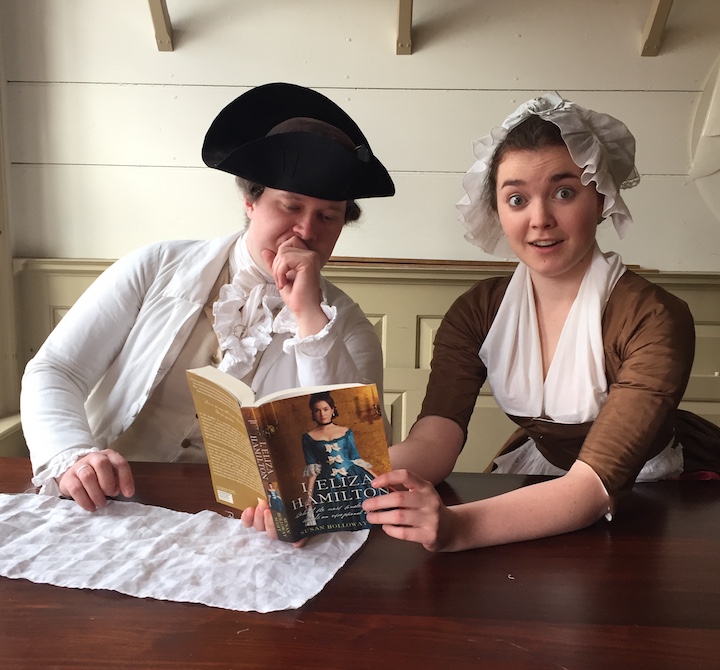Both Eliza and Alexander Hamilton considered themselves New Yorkers, and they both spent more time in their lives there than anywhere else. But they also lived for a number of years in Philadelphia: Alexander took various lodgings when business and government took him to the city, and Eliza and the children joined him in at least one rented house (records are inconclusive) from 1790-1795, when Philadelphia was the country's capital and Alexander was serving as the Secretary of Treasury.
They definitely did live in a house at 79 South Third Street, a lot which now faces onto modern day Walnut Street between Third and Second Streets. The house has long ago vanished, and there is no surviving drawing or other record of its appearance. It was most likely brick and several stories high, as were nearly all of the other houses in the neighborhood. The Hamiltons would have required a good-sized house. The family was a growing one, with four of their own children as well as their adopted daughter Fanny Antill, to be joined by another son in 1792. The household would also likely have included servants. More unhappily, Alexander conducted at least part of his ill-fated affair with Maria Reynolds in this house, while Eliza was away with the children at her parents' house in Albany.
The house's location must have been convenient for Alexander. It was around the corner from the Offices of the Treasury on Third and Chestnut, and also, on the same street, the site of the new First Bank of the United States. (On the east side of Third Street today, across from the bank, stands the new Museum of the American Revolution.) Three blocks to the west, at Sixth Street and Chestnut, was Congress Hall, the home of the United States Congress until 1800. Shops, stables, taverns, and markets were also conveniently nearby.
The Hamiltons's house was on the edge of one of 18thc. Philadelphia's most affluent neighborhoods. On Third Street south of Walnut, shown in the c1800 engraving above, were the mansions of merchant, banker, and legislator William Bingham and his wife Anne; first president of the First Bank Thomas Willing; and real estate magnate and last mayor of colonial Philadelphia, Samuel Powel and his wife Elizabeth. At one time, George and Martha Washington also had a house on Third Street.
Given Alexander's position in the government, it's likely that he and Eliza were frequent guests in the homes of these wealthy and powerful people. Reciprocating their hospitality, however, must have been a challenge for Eliza, given their own much more limited means. Unlike the majority of the other members of the new government, the Hamiltons had no income from a private estate, legacy, or investments, and attempted to live on Alexander's surprisingly humble salary - far less than what he had been earning as a lawyer in New York.
Today a large commercial building sits on the site of the Hamilton house, with an imposing historic plaque facing Walnut Street to commemorate the location. As is too often the way, however, the plaque mentions only Alexander as having lived there, without so much as a hint of Eliza, or their children. I couldn't make a lasting addendum to the plaque, but at least for the photo, below, I made sure Eliza was included.
Above: Birch's View on Third Street, from Spruce Street, Philadelphia, c1800.
Read more about Eliza Schuyler and Alexander Hamilton in my latest historical novel, I, Eliza Hamilton, now available everywhere. Order now.




























